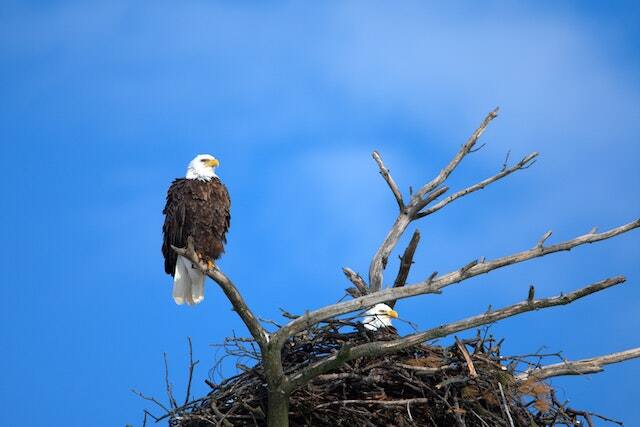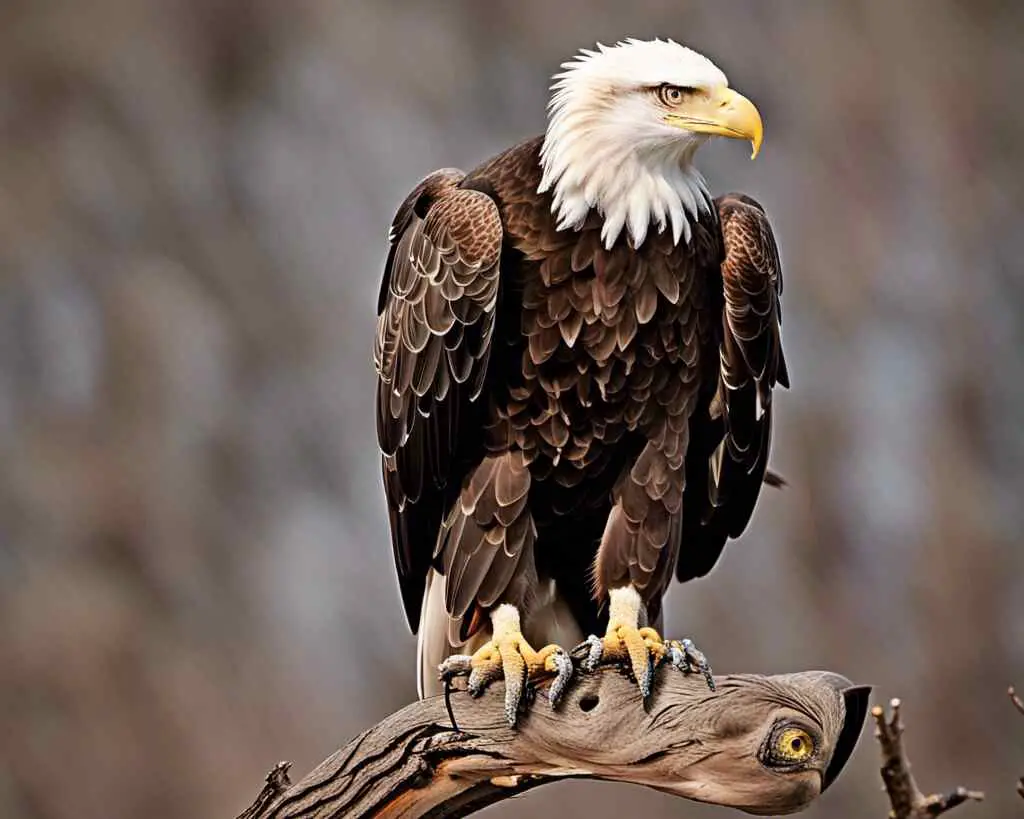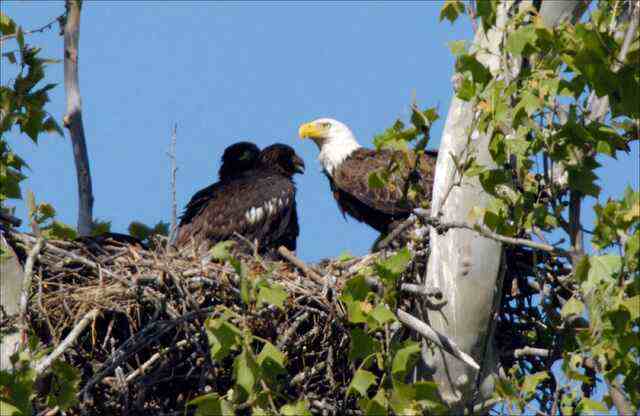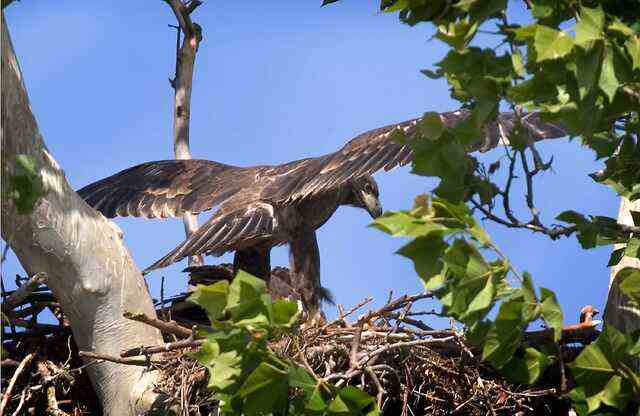In the realm of majestic avian species, none captivates human imagination quite like eagles. These awe-inspiring creatures symbolize freedom and power, drawing us into their world of soaring heights and keen vision.
While we marvel at their impressive wingspans, one burning question lingers: How long do eagles stay with their parents? In this article, we embark on a journey through the fascinating lives of eagle families.
From their nesting period to the fledging stage and beyond, we’ll uncover the secrets of their social interactions, migratory patterns, and enduring bonds.
Prepare to be enthralled as we unravel the mysteries of these remarkable birds.
Table of Contents
- 1 Key Takeaways
- 2 How Long Do Eagles Stay With Their Parents
- 3 Introduction to Eagles and Their Family Dynamics
- 4 The Nesting Period and Early Life
- 5 The Fledging Stage and Independence
- 6 Juvenile Phase and Dispersal
- 7 Migratory Patterns and Seasonal Movements
- 8 Lifespan and Parental Care in Adulthood
- 9 Social Interactions within Eagle Communities
- 10 Threats and Challenges to Eagle Families
- 11 Conservation Efforts and Protection of Eagle Families
- 12 Conclusion: Appreciating the Family Bonds of Eagles
- 13 Frequently Asked Questions
- 14 Conclusion
- 15 Author
Key Takeaways
- Eagles form monogamous pairs and mate for life.
- Both male and female eagles participate in building the nest and caring for the young.
- Eaglets are highly dependent on their parents for food, protection, and guidance.
- Young eagles disperse from their parents and establish their own territories.

How Long Do Eagles Stay With Their Parents
Eagles typically stay with their parents for around 10–12 weeks after hatching. During this period, they learn essential survival skills and are gradually weaned off parental care. Once mature enough, young eagles venture out on their own, establishing their territories and seeking independence.
Introduction to Eagles and Their Family Dynamics
Eagles, known for their majestic appearance and soaring flights, exhibit fascinating family dynamics that contribute to their long-term survival.
Eagle behavior is characterized by strong family bonds and cooperative breeding strategies. Eagles form monogamous pairs that mate for life and share parental responsibilities.
Both male and female eagles participate in building their nest, incubating the eggs, and caring for the young. This division of labor ensures the successful rearing of their offspring.
Family dynamics among eagles also involve territorial defense and cooperative hunting, which further strengthen their bond.
The nesting period and early life of eagles are critical stages in their development, as they learn essential survival skills from their parents. This period sets the foundation for their future independence and eventual departure from their parents’ care.
The Nesting Period and Early Life
During the nesting period, eaglets are highly dependent on their parents for survival. They rely on their parents for food, protection, and warmth.
As they grow older, they undergo a gradual process of learning to fly and hunt, which is essential for their survival as independent individuals.
This period of dependence on their parents is crucial for the eaglets to develop the necessary skills and behaviors needed to thrive in the wild.
Eaglets and Their Dependence on Parents
Throughout their early development, eaglets rely heavily on their parents for food, protection, and guidance. Eaglet behavior is strongly influenced by their parents, who play a crucial role in their upbringing.
From the moment they hatch, eaglets depend on their parents for regular feedings. The parents hunt and bring back prey, tearing it into small pieces to feed their hungry offspring.
This feeding behavior not only provides nourishment, but also teaches the eaglets how to handle and consume their food.
In addition to providing food, the parents also offer protection to their vulnerable young. They guard the nest, warding off potential predators and ensuring the safety of their eaglets.
As the eaglets grow older, they begin to explore their surroundings under the watchful eyes of their parents, gradually gaining independence.
This period of dependence sets the stage for the subsequent section on how eaglets learn to fly and hunt, as they gradually acquire the skills necessary for survival in the wild.
Learning to Fly and Hunt
Learning to fly and hunt is a critical stage in the development of young eagles, as they gradually acquire the essential skills needed for their survival in the wild.
During this stage, eaglets learn various techniques to improve their flying abilities. They practice soaring, gliding, and mastering their wing movements.
Additionally, young eagles learn to hunt and select prey efficiently. They observe their parents’ hunting techniques and gradually develop their own strategies.
They learn to identify suitable prey, such as fish, small mammals, and birds, and develop the necessary hunting skills, including swooping down to catch their target and carrying it back to a safe spot to consume.
These learning experiences are crucial for their future independence and successful integration into the eagle population.
Moving on to the fledging stage and independence, eaglets continue to develop their skills and become self-reliant hunters.
The Fledging Stage and Independence
During the fledging stage, eaglets leave the nest and begin to explore their surroundings. This period is crucial for their development as they learn to fly and acquire the necessary hunting and survival skills.
They gradually become more independent from their parents and start hunting on their own, honing their abilities to catch prey and secure their own sustenance in the wild.
Eaglets Leaving the Nest
Upon reaching maturity, eaglets spread their wings and venture out from the nest, embarking on their own journey of independence. The eaglet’s first flight marks the beginning of their solo exploration and acquisition of survival skills.
This critical milestone allows the young eagle to develop its hunting techniques, which are crucial for its future success.
As the eaglet ventures away from the familiarity of the nest, it begins to observe and learn from its parents’ hunting strategies.
By closely observing their techniques, such as the ability to soar high in the sky and spot prey with their keen eyesight, the young eagle starts to develop its own hunting prowess.
This period of independent exploration and skill development prepares the eaglet for the challenges it will face as it matures into a fully independent hunter, seamlessly transitioning into the subsequent section about solo hunting and survival skills.
Solo Hunting and Survival Skills
Developing a repertoire of hunting techniques and survival skills is essential for the young eagle as it ventures out on its own and takes on the challenges of solo hunting.
To ensure successful hunting expeditions, eagles rely on a range of techniques that they acquire through practice and observation. Some of these techniques include:
- Aerial hunting: Eagles use their exceptional eyesight and agility to spot and catch prey in mid-air.
- Perch hunting: Eagles perch on high vantage points, such as tree branches or cliffs, and scan the surroundings for potential prey.
- Ambush hunting: Eagles hide and wait for prey to come within striking distance before launching a surprise attack.
- Cooperative hunting: In some cases, eagles work together with other eagles or birds of prey to capture larger prey or defend their territory.
- Dive hunting: Eagles plunge from great heights, reaching impressive speeds, to snatch fish from the water.
By honing these solo hunting skills and survival techniques, young eagles become capable hunters, ready to navigate the challenges of the world on their own.
Transitioning into the subsequent section on the ‘juvenile phase and dispersal,’ eaglets embark on a new chapter of their lives, leaving the nest behind.
Juvenile Phase and Dispersal
The juvenile phase of eagles is followed by their dispersal, where they leave their parents and establish their own territories.
During this phase, young eagles develop and refine their survival skills, such as hunting, flying, and finding suitable nesting sites.
Juvenile dispersal is an important step in the life cycle of eagles, as it allows them to avoid competition with their parents and siblings for resources.
This process also helps in the genetic diversity of the population by preventing inbreeding.
Eagles exhibit a wide range of dispersal patterns, with some individuals staying relatively close to their natal area while others travel long distances to establish new territories.
Understanding the factors influencing juvenile dispersal is crucial for conservation efforts and the management of eagle populations.
Transitioning into the next section, migratory patterns and seasonal movements play a significant role in the life of eagles.
Migratory Patterns and Seasonal Movements
During the juvenile phase, eagles gradually develop the skills necessary for survival, including hunting and flying. Once they reach maturity, they typically disperse from their natal area to find their own territories. However, their movements do not end there.
Eagles are known for their remarkable migratory patterns and seasonal movements. These movements are influenced by factors such as food availability, breeding habits, and weather conditions.
Various species of eagles have different migration routes, with some individuals covering thousands of kilometers during their journeys.
These migrations allow eagles to access different food sources and breeding grounds, ensuring their survival and reproductive success.
Understanding the intricacies of these migratory patterns is crucial for conservation efforts and the preservation of eagle populations.
As we delve further into the topic, we will explore the lifespan and parental care in adulthood, which plays a fundamental role in the overall life cycle of eagles.
Lifespan and Parental Care in Adulthood
Lifespan and parental care in adulthood are crucial aspects of eagle ecology, with their survival and reproductive success depending on these factors. Eagles exhibit a high level of parental investment, with both parents participating in rearing their offspring.
The average lifespan expectancy of eagles varies between species, ranging from 20 to 30 years in the wild.
During this period, adult eagles provide extensive care to their young, ensuring their survival and development.
They construct large nests, often using the same nest year after year, and invest considerable time and energy in hunting and providing food for their chicks.
As the chicks grow, adult eagles gradually reduce their parental care and encourage their independence. This transition allows the young eagles to acquire the necessary skills to survive and eventually reproduce.
This section will now transition into discussing social interactions within eagle communities.
Social Interactions within Eagle Communities
In addition to caring for their offspring, adult eagles engage in various social interactions within their communities. Eagle communication plays a crucial role in maintaining social bonds and establishing territories.
Vocalizations, such as high-pitched whistles and screeches, are used for long-distance communication, while visual displays, such as wing flapping and head bobbing, are used for close-range interactions.
These social interactions also contribute to the establishment and maintenance of social hierarchies within eagle communities.
Dominant individuals often have priority access to resources and breeding opportunities, while subordinate eagles may face limited access to food and mates.
Understanding the intricacies of social interactions and hierarchies within eagle communities is essential for comprehending the overall dynamics of these majestic birds.
Transitioning into the subsequent section about threats and challenges to eagle families, it is important to consider the impact of external factors on their social structure and survival.

Threats and Challenges to Eagle Families
Threats and challenges to the stability of eagle families arise from a range of external factors that can disrupt their social structure and hinder their survival.
These challenges include habitat loss, pollution, climate change, and human activities such as hunting and trapping.
Habitat loss due to urbanization and deforestation limits the availability of suitable nesting sites and prey for eagles.
Pollution, especially from chemicals like pesticides and heavy metals, can accumulate in their food sources, leading to reproductive issues and reduced survival rates.
Climate change affects eagle populations by altering their habitats and affecting the availability of prey.
Additionally, human activities such as hunting and trapping pose direct threats to eagle populations.
Conservation efforts play a crucial role in protecting eagle families by mitigating these challenges and ensuring their long-term survival.
These efforts involve habitat conservation, pollution reduction, and strict regulations on hunting and trapping.
By addressing these threats, we can secure the future of eagle families and preserve their important role in ecosystems.
Conservation Efforts and Protection of Eagle Families
Legal protections and habitat preservation are essential aspects of conservation efforts for eagle families. These measures aim to safeguard the natural habitats and nesting sites of eagles, ensuring their long-term survival.
Additionally, monitoring and research initiatives play a crucial role in understanding the behavior, population dynamics, and ecological needs of eagle families, allowing conservationists to make informed decisions and implement effective management strategies.
Legal Protections and Habitat Preservation
Preservation of habitats is crucial for ensuring the long-term well-being and survival of eagles, as it serves as a protective sanctuary that allows these majestic creatures to flourish and maintain their familial bonds undisturbed.
Legal protections play a vital role in safeguarding eagle habitats from encroachment and destruction.
In many countries, laws have been enacted to designate specific areas as protected eagle habitats, prohibiting activities such as logging, mining, and construction that could degrade these environments.
Moreover, habitat preservation efforts aim to restore and enhance existing eagle habitats through reforestation, wetland conservation, and the establishment of wildlife corridors.
These measures help maintain the integrity of the ecosystems that eagles rely on for food and shelter.
By safeguarding their habitats, legal protections and habitat preservation initiatives contribute significantly to the conservation of eagles and the perpetuation of their familial ties.
| Legal Protections | Habitat Preservation |
|---|---|
| Protected areas | Reforestation |
| Prohibition of | Wetland conservation |
| destructive activities | Wildlife corridors |
This focus on legal protections and habitat preservation sets the stage for monitoring and research initiatives, which aim to deepen our understanding of eagles’ behavior and provide vital insights into their conservation needs.
Monitoring and Research Initiatives
Legal Protections and Habitat Preservation have played a crucial role in ensuring the survival and well-being of eagles.
However, in order to further understand and protect these magnificent creatures, monitoring and research initiatives are necessary.
Monitoring techniques such as satellite tracking, radio telemetry, and banding have provided valuable insights into the movements and behavior of eagles.
These techniques allow researchers to study their breeding habits, migration patterns, and habitat preferences.
Additionally, research initiatives have shed light on the factors that affect eagle populations, such as climate change and human activities.
By continuously monitoring and studying eagles, scientists can gather data to inform conservation efforts and develop effective strategies for their long-term survival.
Understanding the complexities of eagle behavior and their relationship with their environment is crucial for their conservation.
Transitioning into the subsequent section about ‘conclusion: appreciating the family bonds of eagles,’ this research further highlights the importance of protecting and appreciating the family bonds that eagles form.
Conclusion: Appreciating the Family Bonds of Eagles
In considering the family bonds of eagles, it is truly awe-inspiring to witness the enduring commitment and profound sense of togetherness that these majestic creatures display.
Eagles are known for their strong family ties, with parents forming a bond that lasts for several years.
They mate for life and work collaboratively to raise their young, ensuring their survival and success.
Monitoring and research initiatives have shed light on the intricate dynamics of eagle families, providing valuable insights into their behavior and ecology.
These initiatives have also contributed to appreciating nature and promoting wildlife conservation.
By understanding the family bonds of eagles, we gain a deeper appreciation for the complexity and beauty of the natural world.
It is crucial to protect and preserve these remarkable creatures, ensuring future generations can continue to marvel at their awe-inspiring family bonds.
| Column 1 | Column 2 | Column 3 | Column 4 |
|---|---|---|---|
| Enduring commitment | Profound sense of togetherness | Collaborative parenting | Wildlife conservation |
| Strong family ties | Valuable insights | Complexity of the natural world | Protect and preserve |
| Mate for life | Shedding light on | Beauty of nature | Awe-inspiring family bonds |
| Lasts several years | Behavior and ecology | Promoting wildlife conservation | Marvel at |
Frequently Asked Questions
How do eagles choose their mates?
Eagle mating rituals involve elaborate courtship behaviors. These rituals include aerial displays, talon clasping, and vocalizations. Through these behaviors, eagles choose their mates based on physical fitness, compatibility, and the ability to contribute to successful reproduction.
What is the average size of an eagle’s nest?
The average size of an eagle’s nest can vary, but it is typically large and sturdy, constructed with branches, twigs, and other nesting materials. The nest serves as a secure and comfortable home for the eagle and its offspring.
How far do juvenile eagles typically disperse from their birthplace?
Juvenile eagle dispersal refers to the distance they travel from their birthplace. Factors affecting dispersal include competition for resources, habitat availability, and parental influence. Understanding these factors is essential to comprehend the dispersal patterns of juvenile eagles.
Do eagles migrate alone or in groups?
Eagle migration is typically a solitary behavior, with individuals often traveling long distances alone. However, some species may form loose groups during migration, possibly for safety or to take advantage of favorable thermals. Eagle social behavior is generally independent and individualistic.
What are the main threats to eagle families in their natural habitats?
The main threats to eagle families in their natural habitats include human impact and habitat loss. Human activities such as deforestation and urbanization can lead to the destruction and fragmentation of eagle habitats, ultimately endangering their survival.
Conclusion
In conclusion, the family bonds of eagles are both remarkable and enduring. Throughout their lives, eagles rely on their parents for guidance and support, from the nesting period to the fledging stage and even during their juvenile phase.
While eagles eventually gain independence and disperse from their families, they maintain social interactions within eagle communities, exhibiting migratory patterns and seasonal movements.
However, these majestic birds face threats and challenges, highlighting the importance of conservation efforts and the protection of eagle families.
The intricate dynamics of eagle families exemplify the resilience and unity of these magnificent creatures, showcasing their unparalleled strength and determination.





